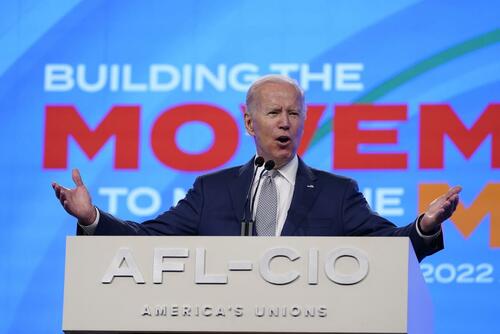 Some interesting data points from the release:
Some interesting data points from the release:
- Blacks employees (11.6%) are more likely to be be union members than whites (10.0%), Hispanics (8.8%) or Asians (8.3%).
- The two states with the highest union rate are Hawaii (21.9%) and New York (20.7%). The lowest are South Carolina (1.7%) and North Carolina (2.8%)
- The most unionized occupations are public safety (34.6%) and education (33.7%). The lowest are sales (3.0%) and computer and math jobs (3.3%).
The proportion of wage and salary workers who are members of unions has dropped to a record low, according to a Thursday data release from the U.S. Bureau of Labor Statistics.
The union membership rate dropped from 10.3% in 2021 to 10.1% in 2022, the lowest mark in a data series that goes back to 1983. Of course, you’d have to go back much farther than 40 years to find a lower rate: University research puts membership in 1964 near 30%.
The new low comes despite a major surge in union-organizing efforts that started during the Covid-19 pandemic. As we reported in July, the number of workplaces filing union petitions hit a six-year high over the first six-months of the year.
Those organizing efforts have included headline-making campaigns to organize Starbucks outlets, Amazon warehouses and Home Depot stores. Those efforts have been hit-and-miss, with successful efforts commanding far more media attention than the failures. In November, employees of a Philadelphia Home Depot overwhelmingly shot down a union proposal by a 165-to-51 vote.
“The BLS numbers are another reminder that headlines from cheerleading reporters and influence in the halls of power in DC are no substitute for actual support among hardworking rank-and-file American workers,” said National Right to Work Foundation Vice President Patrick Semmens.
The lackluster unionization rate also came at a time when Democrats controlled the White House and Congress. It’s not for lack of trying: Most recently, the National Labor Relations Board changed rules to allow smaller groups of employees to form “micro-unions” within a given employer. Imagine the pay, work-rule and benefit complications an employer would face if the mailroom has a union and the rest of the company doesn’t.
AFL-CIO President Liz Shuler blamed the poor 2022 showing on “illegal opposition” from employers. “The wave of organizing will continue to gather steam in 2023 and beyond despite broken labor laws that rig the system against workers,” she said.
The membership rate among government employees more than quintuples that of private sector workers — 33.1% for so-called “public servants”compared to just 6.0% for those who pay the the public employees’ salaries. Just for starters, the National Education Association (NEA) public teacher union has 3 million members and the American Federation of State, County and Municipal Employees (AFSCME) has 1.4 million.
https://www.zerohedge.com/economics/unions-faltering-nationwide-membership-rate-hits-record-low